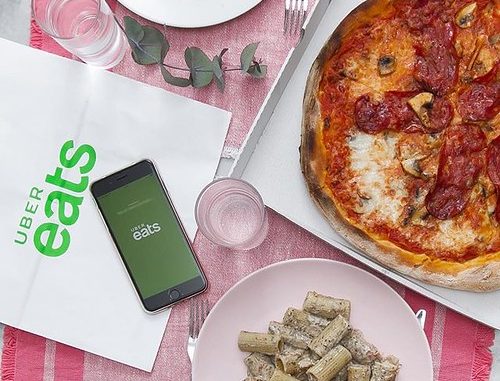
What is Uber Eats
Uber Eats is an online food ordering and food delivery platform launched by Uber in 2014. (Raj et al., 2020) This service is provided through a separate smartphone application of Uber Eats. In just a few years, it has become one of the most professional online food ordering platforms in the world. Uber Eats is committed to advancing the digital development process of the entire catering industry under the sharing economy. (Raj et al., 2020) It allows consumers to order food from selected restaurants, providing users with a convenient and fast ordering experience, while also providing restaurants with integrated operational solutions. Enabling users to get food from their favorite local restaurant has become as easy as calling a car, and it also provides a sales channel for the restaurant, as well as job opportunities for food delivery.
The development of Uber Eats

Uber Eats’ parent company, Uber, was founded in 2009 by Garrett Camp and Travis Kalanick. Uber Eats wasn’t always as popular as it is today. The idea didn’t emerge until 2014 when the company launched a service in California called “Uber Fresh” that served lunch and dinner at selected restaurants. The idea for “Uber Eats” officially emerged in 2015 when executives realized they could tap into a bigger market by expanding their restaurant selection. (Raj et al., 2020)
As of November 2018, the company reported making food deliveries in 200 cities in 20 countries in EMEA (Europe, Middle East, and Africa) markets. In 2019, as part of its expansion into foreign markets, the company announced its intention to open virtual restaurants in the UK. At present, the business scope of this platform covers 45 countries around the world. Fast forward to today, Uber is investing heavily in Uber’s Eats model. The food delivery business has developed rapidly and has a strong momentum around the world. (Cloros, 2019)Uber Eats’ parent company, Uber, was founded in 2009 by Garrett Camp and Travis Kalanick. Uber Eats wasn’t always as popular as it is today. The idea didn’t emerge until 2014 when the company launched a service in California called “Uber Fresh” that served lunch and dinner at selected restaurants. The idea for “Uber Eats” officially emerged in 2015 when executives realized they could tap into a bigger market by expanding their restaurant selection. (Raj et al., 2020)
The domain of business and business model
Uber Eats is mainly accessed through its apps for iOS and Android. The platform focuses on providing users with delicious food services without leaving home, its purpose is to connect its users with a series of local restaurants by displaying a menu of food locations on the user’s smartphone screen and delivering the selected dishes to their doorstep. Not only that, but the head office of Uber has also brought a revolutionary change to the catering industry. They created a restaurant that only serves “Uber Eats” without tables and chairs. These are restaurant kitchens staffed to prepare and deliver food, either for existing brick-and-mortar restaurants wishing to move their delivery operations offsite or for delivery-only restaurants with no walk-in or dining room service. (Muriuki, 2021)
The business model of Uber Eats is multilateral. It is a three-sided market, centered on the Uber Eats platform, connecting drivers, restaurant owners, and customers. (FourWeekMBA, 2021) The trilateral market moves around three participants, and restaurants pay Uber Eats commissions in exchange for the right to sell food on the platform. Customers pay a small amount of freight, and sometimes a cancellation fee for canceling meals due to personal reasons, and drivers make money by providing reliable delivery on time.
It is worth mentioning that the business model and user service system of Uber Eats is based on the existing Uber technology. Uber Eats’ existing customer base is the most valuable asset as a subsidiary of Uber. Uber has invested heavily in the global market. Relying on information collected from ten years of data, Uber Eats is built on this comprehensive infrastructure. Millions of active Uber users around the world may be potential users of Uber Eats. (Muriuki, 2021) Not only customer resources but Uber’s car/driver resources can also be effectively used. Uber Eats uses a strategic and creative way to manage service intangibility through increasing demand and revenue whilst reducing the perishability of unutilized Uber drivers. For example, an Uber driver who has just finished a taxi trip may immediately process food delivery orders in nearby areas. And, the algorithm developed by Uber does a good job of neatly organizing the main elements of an online food delivery system. Namely order management, order allocation, and order dispatch. (Mitchell & Jaquet, 2020)
Is Uber Eats successful?
From Grub Hub, Caviar, and Door Dash to Uber Eats, meal delivery service has become a market with more than 100 billion U.S. dollars. According to Uber CEO Dara Khosrowshahi, Uber Eats is the fastest-growing food delivery service in the United States. In just four years after its launch, its booking operation rate reached $6 billion. There is no delivery service that has grown globally as rapidly as Uber Eats and is well received by customers. Uber Eats scores almost perfect on the App Store and Google Play. From August 2017 to February 2018, its sales doubled, narrowing the gap between them and the industry leader Grub Hub. In August 2017, the market share difference between Grub Hub and Uber Eats was 48%. As of March 2018, the difference had dropped to 28%. (Muriuki, 2021) Part of the reason why Uber Eats is so successful is that consumers’ eating habits have changed. More and more people prefer to order and deliver them to their homes instead of cooking. Food delivery is very convenient because it saves time in preparing meals, especially for people living alone, who think this service is the obvious choice. In 2020, due to the global pandemic and users avoiding social interaction for fear of contracting the virus, Uber Eats’ order volume has increased significantly, and new customers have increased by 30%. (Cloros, 2019)
On the other hand, Uber Eats has been so successful so quickly because of the service, while providing a value proposition to convince customers. Uber Eats provides extremely fast delivery it promises to deliver within 30 minutes in most cities where it currently operates. And it has no concept of a minimum order quantity, the standard delivery fee ensures that all orders are fulfilled, regardless of the order value. Uber Eats’ main competitor Grub Hub usually requires customers to spend at least $20 to obtain delivery services, and in addition to this minimum order, there is usually a shipping cost. In Uber Eats, regardless of the amount of the order, customers can deliver it to the location of their choice at a flat rate. Uber eats also offer discounts for users, discount or free shipping under certain conditions. (Muriuki, 2021) For example when a user recommends a new user to register for Uber Eats, the system will automatically add a certain amount of deduction coupons and discount coupons to their account. With Uber Eats’s free food setting, users even possibly get a meal for free without even having to pay a reservation fee. These are also key elements of Uber Eats’ success as a shared dining platform.
How does Uber Eats make money?
Uber Eats usually has four different sources of income:
Order commission is the main source of income. Uber Eats usually earns 30% commission from restaurant partners, which is the total cost of each order that users use its platform to make. The delivery fee is divided into three parts: pickup fee, delivery fee, distance fee (per mile). Uber Eats will account for 25% of the total amount. In addition, for orders less than $12, Uber Eats will charge $2. Thirdly, some restaurants and food chains will sign special contracts with Uber Eats to provide exclusive promotions on the app to get more sales. Therefore, according to the negotiated agreement, these brands will pay special commissions and fees. Finally, Uber Eats applies the same dynamic pricing algorithm as Uber during peak hours, and charges users additional “busy fees.” (FourWeekMBA, 2021)
Some concerns about Uber Eats
In the three-party business cycle, Uber Eats has also been questioned. Some cooperative restaurants stated that Uber Eats has transferred the responsibility and risk of delivery and logistics to the restaurant, but the restaurant really cannot control the route the driver takes, this will also increase confusion for users. (Batey, 2020) When the food is not delivered on time, they can only ask the restaurant, but the restaurant cannot answer the whereabouts of the food. Also, Uber Eats charges a 30% commission to the restaurant, which is what most restaurants work on as a gross profit, making the restaurant almost unable to make any gross profit anyway. (Keng, 2018) With regard to delivery drivers, consumer regulators have expressed concerns about Uber’s standard contract with its drivers, especially the terms that allow Uber to terminate the agreement “without reason”. (Chau, 2018) In response to these potential problems, Uber Eats should find a mutually beneficial and equal transaction method for the three parties.

Conclusion
In summary, Uber Eats is a rapidly developing sharing economy platform. Although it has hit the old restaurant industry, it has also promoted new ways of cooperation. More importantly, it has facilitated people’s lives. More and more people choose Uber Eats, which also proves that it is successful. However, Uber Eats is a multi-party cooperation business model after all. It still has to ensure that all aspects are fair, and it should also be responsible for the user’s service to the end.
Reference
How Does Uber Eats Make Money? Uber Eats Business Model In A Nutshell – FourWeekMBA. FourWeekMBA. (2021). Retrieved 17 October 2021, from https://fourweekmba.com/uber-eats-business-model/.
Chau, D. (2018). Uber Eats imposes ‘unfair contracts’ and ruins deliveries, restaurateurs allege. Abc.net.au. Retrieved 17 October 2021, from https://www.abc.net.au/news/2018-04-22/uber-eats-criticised-over-conditions-on-restaurant-owners/9662814.
Keng, C. (2018). Why Uber Eats Will Eat You Into Bankruptcy. Forbes. Retrieved 17 October 2021, from https://www.forbes.com/sites/cameronkeng/2018/03/26/why-uber-eats-will-eat-you-into-bankruptcy/?sh=6dc8102721f6.
Raj, M., Sundararajan, A., & You, C. (2020). COVID-19 and Digital Resilience: Evidence from Uber Eats. SSRN Electronic Journal. https://doi.org/10.2139/ssrn.3625638
Cloros, A. (2019). The future of Uber Eats – hospitality | Magazine. hospitality | Magazine. Retrieved 17 October 2021, from https://www.hospitalitymagazine.com.au/the-future-of-uber-eats/.
Muriuki, P. (2021). Why you should focus on the Uber Eats success. Startup.info. Retrieved 17 October 2021, from https://startup.info/why-you-should-focus-on-the-uber-eats-success/.
Mitchell, T., & Jaquet, C. (2020). Uber Eats. Revue Du Crieur, N°15(1), 76. https://doi.org/10.3917/crieu.015.0076
Batey, E. (2020). Delivery Apps Refuse to Temporarily Decrease the Fees They Charge Restaurants. Eater SF. Retrieved 17 October 2021, from https://sf.eater.com/2020/4/3/21207395/postmates-uber-eats-doordash-commissions-fees-delivery-coronavirus.

This work is licensed under a Creative Commons Attribution-NonCommercial 2.0 Generic License.


